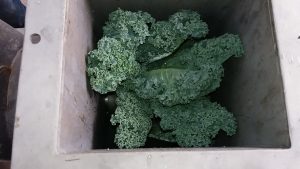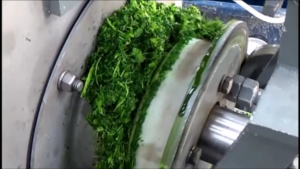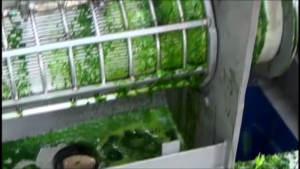Recently we ran trials aimed at producing organic kale juice. Kale is a popular green leafy vegetable. The juice was for a small scale operation so our goal was to use only one machine, a screw press. Overall the results were good. 54% juice yield was achieved.
The press liquor (juice) had some pulp, none of which tended to settle out. It did measure 7% solids content. However this was largely in the form of dissolved solids since the Brix measured 5.5º.
The as-received kale had 86% moisture content. As is frequently the case with raw vegetable material, the press cake produced by the screw press measured the same 86%. We did get some reduction, to 82% moisture, with a second pressing.
Here is a link to the video of that test: JUICING KALE https://youtu.be/7ggDAG5z6PM
Throughput was low, but still likely to be adequate for a small operation. The first step for increasing the production rate would be to run the kale through a shredder ahead of pressing. For a still larger scale operation, it is likely that a twin screw press would come into play. The twin screw press has improved internal shredding action because of the increased number of resistor teeth between the compression stages. And capacity increases because the overlap between the two screws results in one screw pushing along any material tending to co-rotate with the other screw.
Our testing shows the difficulty in predicting the throughput capacity of a screw press. We ran the kale test with a Model KP-6 screw press whose brochure rated capacity is 300 to 1,000 pounds per hour (pph). Because the bulk density of the kale was quite low, to achieve higher throughput capacity we cranked the speed of the screw up to 39 rpm (120 Hertz, double the normal). And we reduced the air pressure on the discharge cone to only 8 psi. With all this our throughput capacity was still only 125 pph. (Juice yield was fair, 26% by weight.)
The press cake produced still had a lot of free juice, so we ran a double pressing. In order to maximize the juice yield, we slowed the press down to 6.5 rpm and increased the air pressure to 30 psi. Normally this would reduce throughput capacity. But because of the higher bulk density of the material being pressed, the throughput capacity almost doubled up to 230 pph. (This second pressing gave us 38% juice yield, which gave us an overall juice yield of 54% with the two pressings.)
We ran our next scheduled sample material, testing it in the same press, with the same screw, screen, and rotating cone. The screw speed was left at 6.5 rpm. The test material we’d been sent was “potato peel with ash” — whatever that is. The throughput came out 850 pph! It was apparent that this material was relatively viscous. Had it had been more dilute, with less pectin, we probably could have reached our old brochure rating of 2,500 pph.
Obviously the throughput ratings of screw presses can vary a great deal.


FRESH KALE IN INLET HOPPER PRESS CAKE

PRESS LIQUOR (JUICE)
